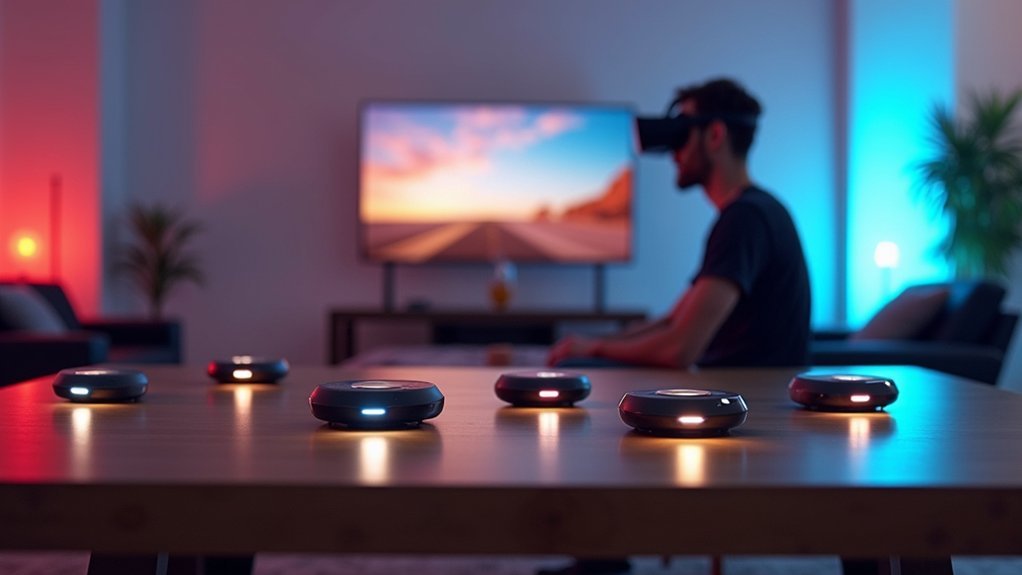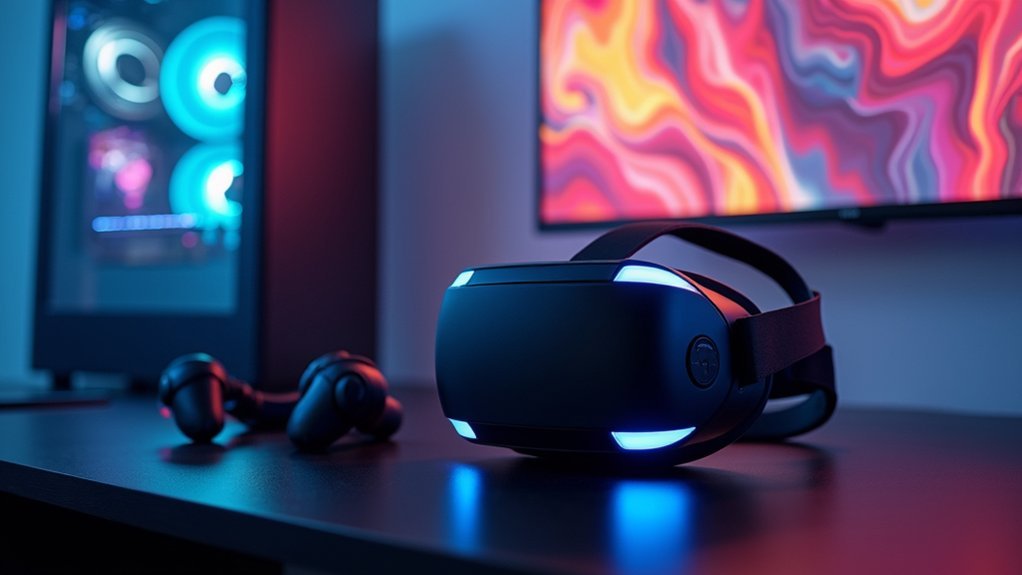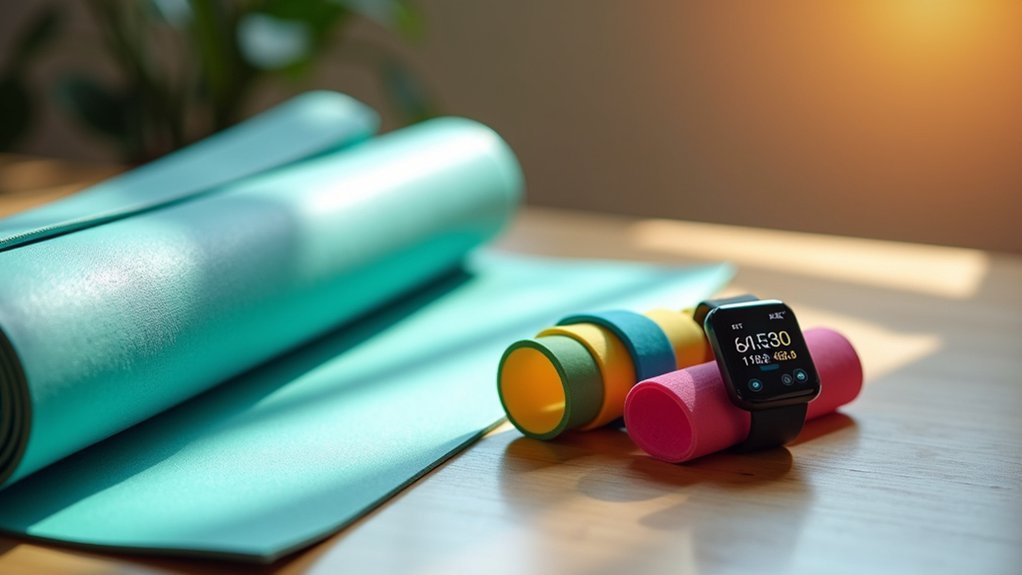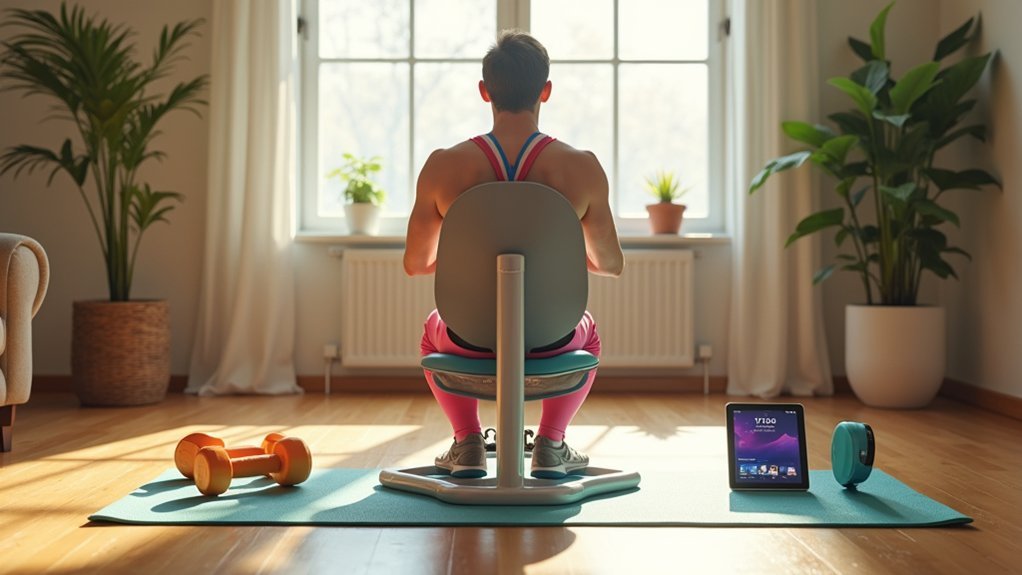Position your router centrally in your play area and switch to the 5GHz band to reduce interference. Mount tracking base stations 6.5-10 feet high at 30-45 degree angles with clear line of sight. Keep metal objects and reflective surfaces away from your setup, and limit active wireless devices on the same frequency. Update firmware regularly and recalibrate after environmental changes. These foundational steps will dramatically improve your wireless VR experience, but there’s much more you can optimize.
Optimize Router Placement and Network Configuration

Why do some VR users experience seamless tracking while others struggle with constant interruptions? The answer often lies in router placement and network configuration.
Position your router centrally in your VR play area to guarantee even signal distribution and eliminate dead zones that compromise tracking accuracy.
Central router placement ensures consistent signal strength throughout your play space, preventing tracking dropouts that disrupt immersion.
Switch your Wi-Fi connection to the 5 GHz band instead of the crowded 2.4 GHz frequency. This reduces interference from other devices and maintains stable tracking performance.
Use a WiFi scanner to identify the least congested channels and configure your network accordingly.
Keep your router away from large metal objects and reflective surfaces that disrupt signals.
Finally, update your router’s firmware regularly to access the latest performance improvements, guaranteeing peak performance for your wireless VR tracking system.
Choose the Right WiFi Frequency Band for Your VR Setup
Router placement sets the foundation, but selecting the correct WiFi frequency band determines whether your VR tracking performs smoothly or suffers from constant disruptions.
The 2.4 GHz band offers wider coverage but creates signal interference issues due to congestion from other wireless devices, negatively affecting your VR performance. You’ll get better results switching to the 5 GHz band, which delivers faster data rates and lower latency essential for high-quality VR experiences.
Use WiFi Scanner tools to assess congestion levels in both bands before deciding.
When running multiple devices, the 5 GHz WiFi frequency band considerably reduces interference and improves connection stability.
For environments with dense wireless traffic, consider upgrading to WiFi 6E’s 6 GHz band for even less congestion and superior VR performance.
Minimize Interference From Household Devices and Metal Objects
Everything around your VR setup can potentially disrupt tracking signals, from the metal filing cabinet in the corner to the smart doorbell constantly pinging your network.
Large metal objects like computer cases and filing cabinets distort VR tracking signals, so you’ll want to maintain distance between these items and your tracking equipment. Reflective surfaces create additional problems by bouncing infrared signals, causing tracking instability—cover mirrors and glass surfaces when possible.
Reduce interference by limiting active wireless devices on the same frequency band. Smart home gadgets, Wi-Fi routers, and other household devices operating on 2.4 GHz create congestion that disrupts tracking performance.
Position your dongles away from large conductive materials and guarantee physical separation between tracking components to enhance signal quality and minimize multipath interference.
Position Tracking Base Stations for Maximum Coverage
Where you mount your base stations determines whether you’ll experience seamless tracking or constant stuttering interruptions.
Position tracking accuracy depends on proper base station placement that maximizes coverage throughout your play area.
Mount your base stations 6.5 to 10 feet high with clear line of sight to your entire play space. Angle them downward at 30 to 45 degrees to capture the full area while reducing blind spots.
Place base stations diagonally opposite each other to create overlapping coverage zones that enhance headset and controller detection.
Maintain at least 10 feet between base stations to prevent signal interference. Closer placement causes tracking issues from signal overlap.
Regularly assess your setup’s performance and adjust base station angles based on user feedback to maintain ideal functionality.
Manage Multiple Tracker Connections to Prevent Signal Overlap

When you’re using multiple VR trackers simultaneously, signal overlap becomes your biggest enemy. Each tracker operates in the 2.402-2.48 GHz frequency range, creating potential interference that disrupts your VR headsets’ connections and degrades performance.
Start by pairing hand controllers to your headset receivers first, then connect additional trackers sequentially using designated dongles. This one-at-a-time approach prevents channel conflicts and simplifies troubleshooting.
Position dongles at adequate distances from each other to minimize mutual coupling effects that occur when antennas are too close. Limit the number of active trackers to reduce signal congestion, as the human body can absorb these frequencies.
Regularly adjust dongle placement, ensuring clear line of sight from your usual playing position for seamless VR tracking performance.
Create an Ideal Play Area Environment for Consistent Tracking
Although you’ve optimized your tracker connections, your play area environment dramatically impacts tracking consistency and accuracy.
Creating the ideal space requires careful attention to several environmental factors that directly influence your VR experience.
Remove reflective surfaces like mirrors, glass tables, and shiny decorations that can cause infrared laser bounce and disrupt tracking performance.
Position your play area centrally within the room, away from walls and furniture that might interfere with sensor line of sight.
Essential setup considerations include:
- Surface variety: Add varied patterns to walls and floors since completely smooth surfaces hinder orientation
- Clear boundaries: Use soft mats or padded flooring to define safe movement zones
- Regular maintenance: Conduct thorough room setup looking in all directions and check for new obstacles
Update Firmware and Calibrate Your VR System Regularly
Beyond environmental enhancement, maintaining your VR system’s software and calibration settings directly affects tracking performance.
You’ll want to update firmware regularly to access the latest performance improvements and bug fixes that enhance tracking reliability. Check manufacturer websites for updates and install them promptly.
After firmware updates or environmental changes, calibrate your VR system using the manufacturer’s recommended procedures. This guarantees ideal tracking precision and addresses potential drift issues.
Take advantage of built-in calibration tools to assess your setup and identify problems before they impact your experience.
Don’t forget regular maintenance – clean your headset and tracking devices to prevent dirt from interfering with sensors.
Schedule periodic calibration reviews, especially after moving furniture or changing lighting, to maintain consistent tracking accuracy throughout your VR sessions.
Frequently Asked Questions
How to Make VR Tracking Better?
You’ll improve VR tracking by positioning dongles away from reflective surfaces, using 5 GHz Wi-Fi, limiting active trackers, pairing controllers sequentially, and covering mirrors or shiny objects near your play area.
How Do I Maximize My VR Performance?
You’ll maximize VR performance by upgrading your graphics card, closing background applications, adjusting in-game settings, ensuring adequate cooling, updating drivers regularly, optimizing Windows settings, and maintaining sufficient RAM for smooth gameplay experiences.
How to Get Better Wifi in VR?
You’ll want to upgrade to a Wi-Fi 6 router and position it centrally in your play area. Use ethernet when possible, scan for less congested channels, and consider Wi-Fi 6E for the 6GHz band’s reduced interference.
Is VR Harder on CPU or GPU?
VR’s harder on your GPU than CPU. You’ll need strong graphics processing for high-resolution rendering at 90+ FPS, while your CPU handles lighter tasks like game logic and physics calculations.





Leave a Reply